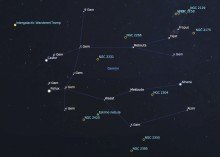Gemini (the Twins), is ideally placed for viewing in the East at this time of year, and there’s lots to observe. It’s one of those constellations that actually resembles what it’s said to be: twin brothers, arm in arm.
Starting at the left of the constellation, two stars represent the heads of the twins, Castor (the upper one) and Pollux. The latter is an orange giant star, approximately 34 light years from the Earth (in fact, it’s our closest giant star). At nearly nine times the radius of the Sun, it’s the brightest star in Gemini.
Castor is a fantastic visual binary star system, and is well worth a look in a telescope. Both stars are a bright white, and require magnification of at least x50 to resolve. I say ‘visual binary’, because it’s thought that there are actually six stars in the system, but only two being visible to the amateur astronomer.
Although not technically within the borders of Gemini (it’s actually in Lynx), just to the left and up from Castor lies the globular cluster NGC 2419 (also known as Caldwell 25, or the Intergalactic Wanderer). At 300,000 light years distant and magnitude 9 it is quite dim, despite being 900,000 times more massive than the Sun. Scopes larger than four inches in diameter should be able to pick it up, and it’s well worth a look.
Globular clusters are few and far between over the winter months (M15 and M2 will be around for a few weeks yet, though low in the West), with C25 and M79 the only two within range of moderate scopes.
There are a number of open star cluster in Gemini: NGC 2420, NGC 2304, NGC 2355, NGC 2395, NGC 2158, NGC 2129, and, largest of them all, Messier 35. The latter occupies an area of the sky similar to that of the full moon, and is visible to the naked eye under good skies. At2800 light years away, and containing several hundred stars, it really is a spectacular object when viewed with even moderate telescopes.
In his book, The Observer’s Book of Astronomy, Patrick Moore described Gemini as: “… a very rich constellation, and is worth sweeping with a low power.” This is largely because of the wealth of open star clusters in the region, plus several binary and/or colourful stars (including Pollux, 46 Geminorum, Mebsuta, Tejat, Propus, 69 Geminorum – all shown on the accompanying image).
Just below the lower of the twins is the Eskimo planetary nebula. It’smore than 2870 light-years away, but should be visible with a small telescope (although aperture, magnification, and perhaps a nebula filter will improve the view).
What’s up?
Staying with Gemini, the Geminid meteor shower starts around the 7th of December, and peaks on the 13th (at which point we can expect around 120 meteors per hour!). Unfortunately, the peak time corresponds with the next full Moon, but it’s still worth having a look in the early part of the month.
As for planets, Venus is still visible (bright and low in the Southwest at sunset); Uranus is nicely placed in the evenings, high to the South; Neptune is low in the West by about 10pm; and Jupiter’s bright and low in the East just before sunrise.
The next New Moon is on the 29th of November, so this is a great time for some deep sky observing. I can’t wait for my next chance to bag some elusive Caldwell objects: C56 and 62 in Cetus (in the South), and the enticingly-named Cleopatra’s Eye planetary nebula in the East.
As I mentioned earlier, globular clusters are rare in the Winter skies, so why not have a look for M15 in Pegasus while you can. It’s home to over 100,000 stars, and is visible at magnifications of 10x and up, putting it within reach of binoculars and small telescopes.
Clear skies!
Kevin Quinn is an amateur astronomer based in Cerne Abbas. He is the proud owner of a ten-inch reflector, a small refractor, a case of eyepieces, and a couple of pairs of binoculars. He tweets via @CerneAstro, and blogs (occasionally) via theastroguy.wordpress.com.
©Kevin Quinn







